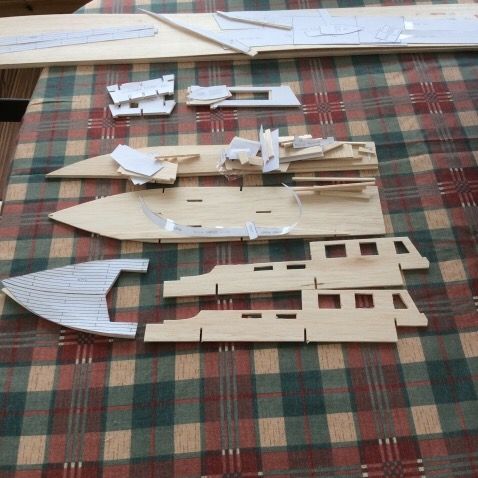Hmm…. quite a lot to consider there!
There are lots of ways to get into model boating, of course – and it's probably worth waiting for a few more people to come round with their ideas and advice!
In (what I think is) your position, I would not be looking at specific boats at the moment. I'd be looking at the local facilities and where I might be able to sail the boat – and then making a choice accordingly. Are you up in the Hebrides? Lots of quite big lakes up there, and it can get quite windy – you might find a high-sided boat like the Sea Princess more suitable for those conditions? And bigger boats are easier to work on if you're installing radio – the PT boat can be quite fiddly. Then, again, if you print out the A4 plans on A3, you automatically go up a size…
The classic wooden boats in the UK were the old 'Aerokit' range – these were made with bulkheads in 1/8" or 5/32" birch resin-bonded ply and skinned in 1/16" ply. Keels might be 1/4" ply for the bigger ones. This is often called 'Marine' to distinguish it from 'Lite-Ply', which is poplar-based, and not waterproof, and good for planes. Here are a couple of links to good suppliers:
**LINK**
**LINK**
There is a wide selection of sheet modelling materials. You can get Obechi, Basswood, Balsa, Ply, various veneers, MDF, Spruce – and that's just some of the woods. You can get ABS, Styrene, Depron, Acrylic, Fibreglass/Carbon fibre and Correx – some of the plastics. And then there's metals… Each of these have particular qualities, different ways of cutting, joining, gluing and finishing… Really, it's best to find a place which stocks a lot of them and have a look yourself. Here is a link to an architectural model supplier in London that you can browse to get an idea of materials available:
**LINK**
As you go to bigger boats and harder materials, you will need better cutting/sanding capability, and probably different glues. 1/16"/1.5mm Lite-Ply is fairly easy to cut with a good modelling knife, but for 1/16" Birch ply you really need a Stanley. By the time you get to 1/8" and 1/4", you need a fretsaw. Balsa cement will not work so well on less absorbent surfaces – you need to be thinking about waterproof PVA, Aliphatic or Epoxy.
There should be no need to reinforce any of the 50+ bows – they are actually quite strong, and will be even better with 1/6" Lite-Ply (properly sealed) skins. If you are looking to make them somewhat bigger, you might need to add extra bulkheads to provide more support to the sides and hull bottom – See Steve Heward's double-sized Triton at the bottom of this page: **LINK**
Radio has a separate page on the EeZeBilt site – **LINK** – but many of the links are outdated. That should kick off a discussion all of its own – the two camps respectively support more costly but better made reliable equipment, or the cheap-as-chips kit from China – less well-made, but with no support if it goes wrong….
For the small EeZeBilts I am firmly in the 'cheap' camp, particularly if someone is just trying out the hobby. If there is a club nearby you can always get advice and practice there before buying, but I'm guessing that you are on your own? What I would do in your position is buy a cheap 2.4Ghz 2-function radio from Hobby-King or somewhere similar – here's an example: **LINK**
You usually buy radios as a Transmitter/Receiver combo and then add a servo (for the rudder) and an Electronic Speed Control (ESC) for the motor separately. Small servos are a few pounds – the ESC you need will depend on the motor you want to buy.
Well – that set of advice ought to ruffle a few feathers – what do other people think?





